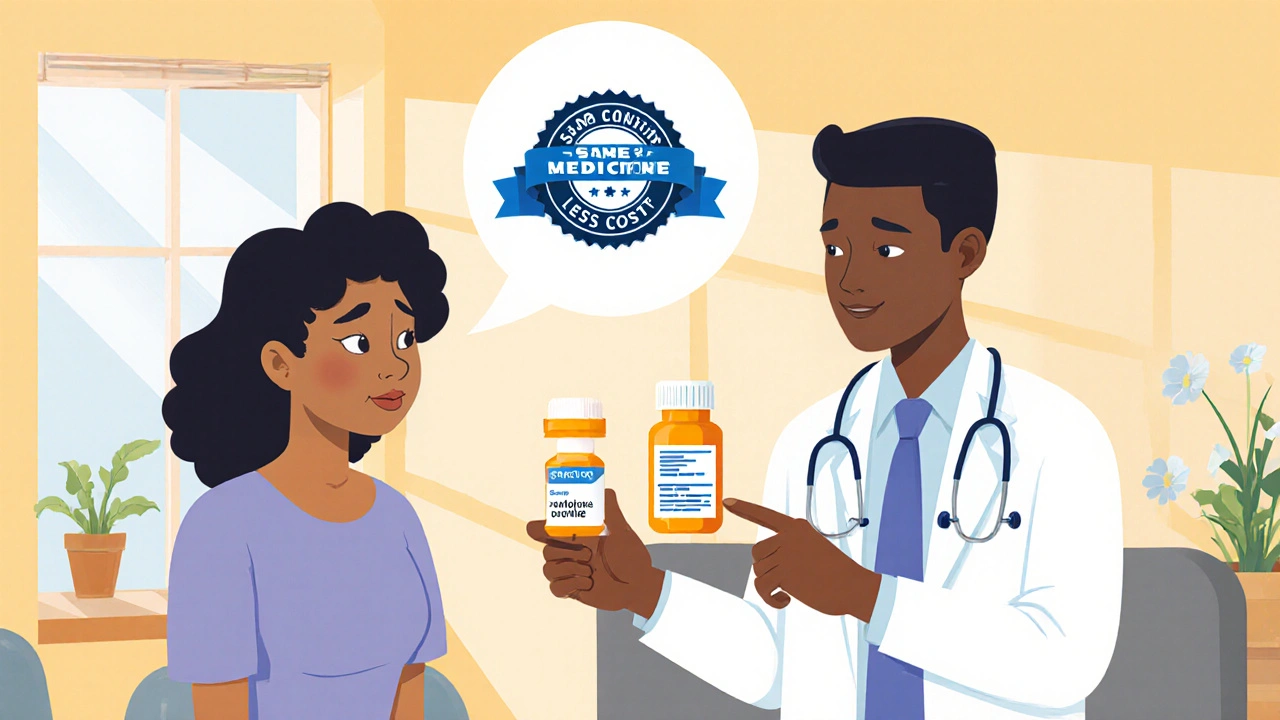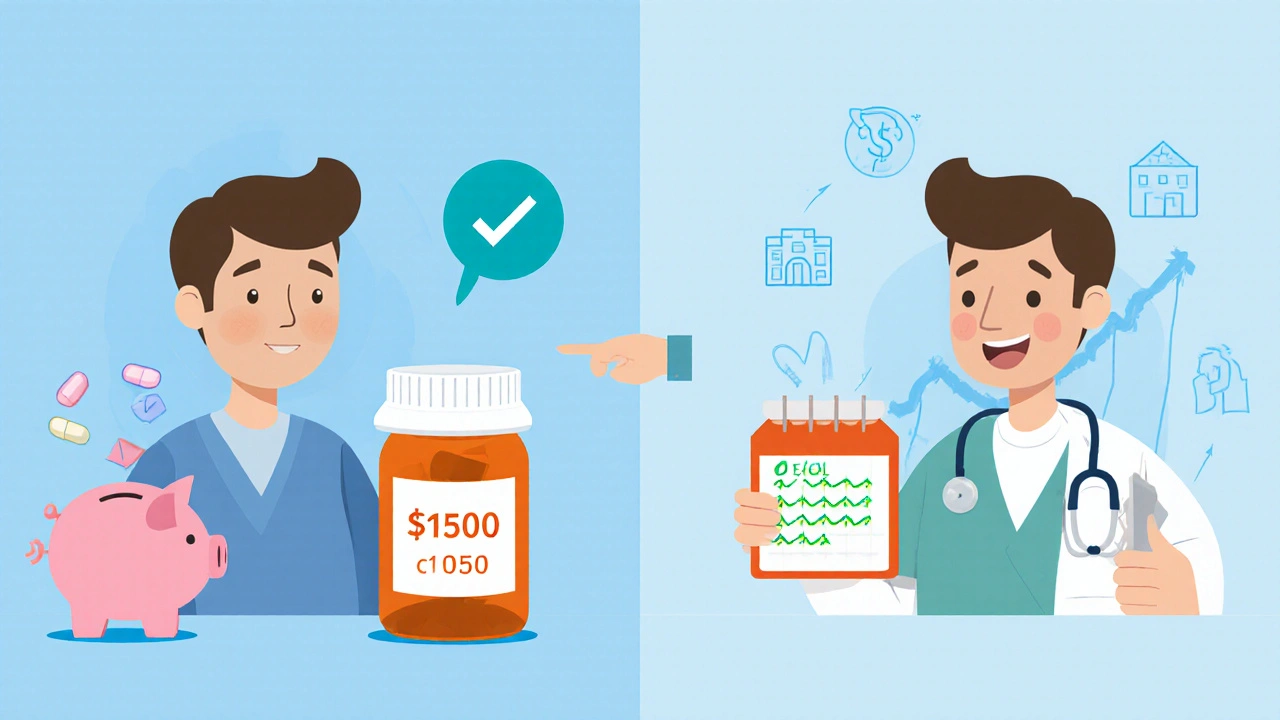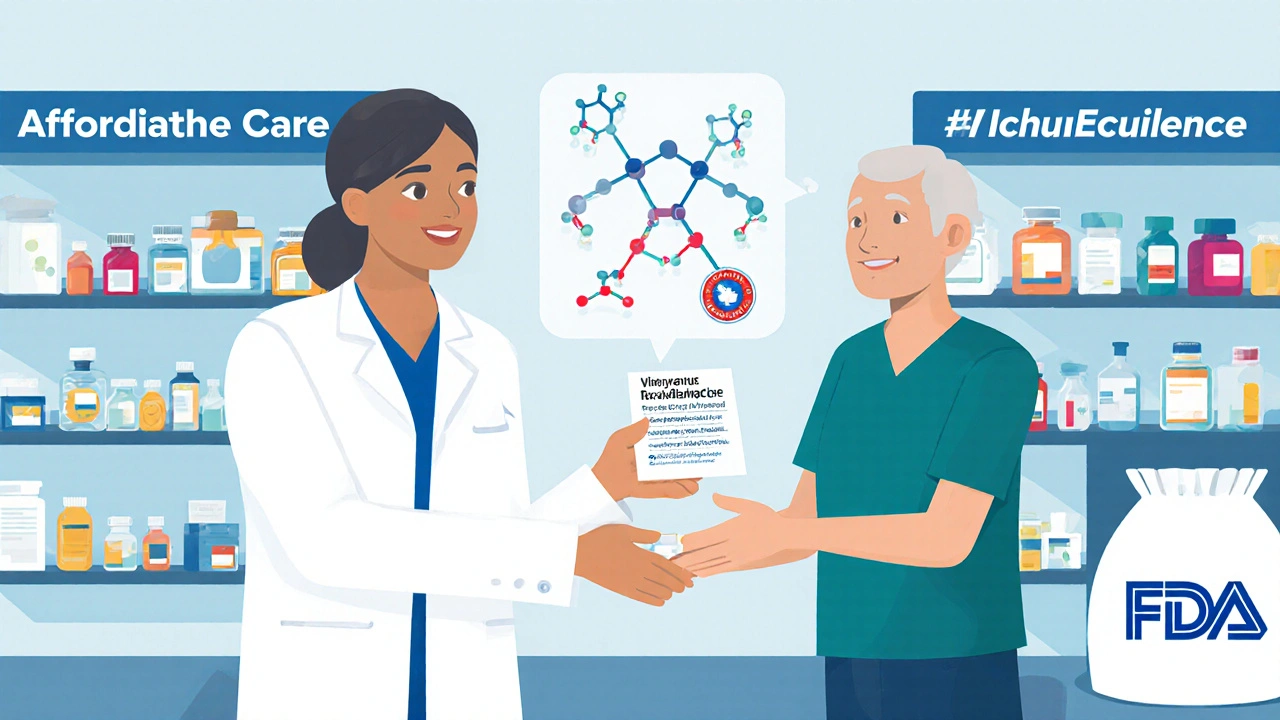How Providers Can Advocate for Generic Medications to Improve Patient Outcomes
 Nov, 21 2025
Nov, 21 2025
When a patient walks out of the clinic with a new prescription, they’re not just getting a pill-they’re getting a promise. A promise that the medicine will work. That it won’t break their budget. That they can take it every day without fear or confusion. But too often, that promise falls apart before it even begins-not because the drug doesn’t work, but because the patient doesn’t trust it.
Why Patients Doubt Generic Drugs
Generic medications are just as safe and effective as brand-name drugs. The FDA requires them to have the same active ingredients, strength, dosage form, and route of administration. They must also prove they’re bioequivalent: meaning they deliver the same amount of medicine into the bloodstream at the same rate as the brand version. That’s not a guess. It’s science. Yet, many patients still believe generics are inferior. Why? Because they look different. The color, shape, or size changed. The pill has a different imprint. They remember taking the brand version before and now, suddenly, it’s not the same. Without explanation, it’s easy to assume something’s wrong. Some patients even think the pharmacy made a mistake. A 2015 review in PMC found that despite decades of evidence showing equivalent outcomes, a strong belief persists among patients that generics are less effective. This isn’t about ignorance-it’s about fear. And fear doesn’t disappear with a pamphlet. It disappears with a conversation.The Cost Gap That Changes Everything
The numbers don’t lie. In 2019, the Association for Accessible Medicines analyzed 1.4 billion prescriptions and found that new patients abandoned brand-name drugs at a rate 266% higher than generics. Why? Because of copays. Ninety percent of generic copays were under $20. Only 39% of brand-name copays were that low. For someone paying out of pocket, that’s not a small difference. It’s the difference between filling a prescription and skipping it. And skipping doses-especially for chronic conditions like high blood pressure, diabetes, or depression-leads to hospitalizations, complications, and higher long-term costs. Providers know this. But too often, they don’t say it. They write the script. They assume the patient knows. They don’t explain that switching to a generic could save them $50, $100, even $200 a month. That’s not just a savings. It’s a lifeline.What Providers Can Actually Do
Advocating for generics isn’t about pushing a cheaper option. It’s about helping patients get the treatment they need without financial harm. Here’s how to do it right:- Start the conversation before the prescription is written. Say: “There’s a generic version of this medication that works the same way and costs a lot less. Would you like to try it?”
- Explain the science simply. “The FDA makes sure generics are just as strong and safe as the brand name. They have to prove it before they can sell it.”
- Address appearance changes proactively. “Sometimes the pill looks different because it’s made by a different company. That doesn’t mean it’s weaker. It just means it’s cheaper-and just as effective.”
- Connect cost to health outcomes. “If you can’t afford this pill, you won’t take it. And if you don’t take it, your condition could get worse. This generic lets you stay on track without the stress.”
- Use the pharmacy as a partner. Pharmacists are often the first to notice confusion. Encourage them to explain differences at pickup. A quick note from the prescriber like “Please counsel patient on generic substitution” can make all the difference.

When Generics Aren’t the Right Choice
Not every drug should be switched. Some medications have a narrow therapeutic index (NTI)-meaning the difference between a helpful dose and a harmful one is very small. For drugs like warfarin, levothyroxine, or certain anti-seizure medications, even tiny variations in absorption can matter. The American Academy of Family Physicians (AAFP) rightly opposes mandatory substitution for these cases. But that doesn’t mean avoiding generics altogether. It means being intentional. For NTI drugs, stick with the brand if the patient is stable on it. If switching is necessary, do it under close monitoring. Document the change. Follow up. Educate. Don’t assume. The key isn’t blanket substitution. It’s informed, individualized care.Why Providers Are the Missing Link
Patients trust their doctors more than any advertisement, website, or pharmacist. A 2015 study found that when a provider supports a generic drug, patients are far more likely to accept it-even if they had doubts before. That’s the multiplier effect. A doctor’s endorsement overrides fear. A simple sentence like, “I’ve prescribed this generic to hundreds of patients. It works just as well,” carries more weight than any FDA brochure. And here’s the hidden benefit: talking about generics saves time later. When patients understand why they’re taking a different-looking pill, they’re less likely to call the office confused. They’re less likely to stop taking it. They’re less likely to end up in the ER because their blood pressure spiked. One study showed that patients who received counseling about generic substitution were 40% more likely to stay on their medication long-term. That’s not just adherence. That’s better health.

Robert Gallagher
November 23, 2025 AT 02:42Just saw a patient stop their blood pressure med because the generic looked different. No explanation. Just panic. We’ve all been there. A 30-second chat before scribbling the script could’ve saved a trip to the ER. It’s not rocket science, it’s basic human communication.
Christopher Ramsbottom-Isherwood
November 23, 2025 AT 19:49Let’s be real - most providers don’t care. They’re rushing through 20-patient days. They write the script, hand over the slip, and move on. The system’s broken, not the patients. Blaming patients for being scared is lazy. Fix the time crunch first.
Stacy Reed
November 24, 2025 AT 19:01Isn’t it fascinating how we’ve outsourced trust to pharmaceutical companies and then wonder why people are afraid of pills that look different? We’ve turned medicine into a commodity, then acted shocked when people treat it like a lottery ticket. The real issue isn’t generics - it’s the erosion of relational care.
Howard Lee
November 26, 2025 AT 07:30I’ve been prescribing generics for 18 years. Never had a patient die because they took the blue pill instead of the green one. But I’ve had plenty die because they couldn’t afford the green one. This isn’t a debate. It’s a moral obligation. Say it clearly. Say it kindly. Say it often.
Nicole Carpentier
November 26, 2025 AT 16:58My mom switched to generic levothyroxine and got dizzy for two weeks. We thought it was the med - turned out she was dehydrated. But she didn’t say anything for a week because she was scared to ‘bother’ the doctor. We need to normalize asking questions. Not just explain the pill - explain the permission to speak up.
Hadrian D'Souza
November 28, 2025 AT 08:31Oh wow, a whole essay on how to tell people ‘this blue pill is the same as the red one’. Groundbreaking. Next up: ‘How to convince patients that water is wet’. The real problem? Pharma companies spent billions convincing people the brand name is sacred. Now we’re surprised they believe it? Please. Fix the ads, not the doctor’s bedside manner.
Brandon Benzi
November 29, 2025 AT 10:22Generics are a socialist plot to dumb down American healthcare. You think a pill made in some foreign factory is equal to American-made medicine? Wake up. The FDA doesn’t inspect those plants like they do here. You’re risking lives for a $15 savings.
Abhay Chitnis
November 30, 2025 AT 19:21Bro, I’m from India, generics are our bread and butter. We’ve been using them since the 80s. No one here thinks they’re weak. In fact, we have some of the best generic manufacturers in the world. Why do Americans act like generics are some kind of conspiracy? 😅
Robert Spiece
November 30, 2025 AT 22:17You call this advocacy? You’re just teaching doctors to be better salespeople. What about the fact that 70% of generic manufacturers are owned by the same conglomerates that make brand-name drugs? You’re not fighting the system - you’re just repackaging its lies with a nicer tone.
Vivian Quinones
December 2, 2025 AT 10:55I don’t care what the science says. My cousin took a generic and got sick. So I’m not taking it. Science doesn’t fix people. Experience does. And my cousin’s experience says no.
Eric Pelletier
December 2, 2025 AT 17:01For NTI drugs like warfarin, the bioequivalence margin is ±20% - but the therapeutic window is often ±10%. That’s why some patients experience INR fluctuations after switching. It’s not that generics are unsafe - it’s that the pharmacokinetic variance, while statistically insignificant in trials, can be clinically meaningful in vulnerable populations. Monitoring and documentation are non-negotiable.
Marshall Pope
December 3, 2025 AT 08:41they said the generic was the same but mine looked like a tiny yellow rock and i was scared to take it. i asked the pharmacist and he said ‘its fine’ but i still felt weird. maybe i just need to trust more?
Nonie Rebollido
December 4, 2025 AT 16:27My grandma switched to generic insulin and cried because she thought they replaced the medicine with ‘water stuff’. I sat with her for an hour and showed her the FDA page. She’s been on it for 6 months now. No issues. Just needed someone to sit down and say it’s okay.
Agha Nugraha
December 5, 2025 AT 02:39Interesting point about supply chain issues. In my country, we’ve seen price spikes for generic antibiotics too. Maybe the solution isn’t just talking more - but pushing for diversified manufacturing and price caps. Trust starts with reliability.
Andy Smith
December 6, 2025 AT 22:14One thing missing from this discussion: electronic health record alerts. If a patient has previously discontinued a generic due to perceived ineffectiveness, the system should flag that for the provider - not just as a note, but as a prompt: ‘Patient previously declined generic; consider pre-emptive counseling.’ Integration, not just intention, drives change.
Rekha Tiwari
December 7, 2025 AT 10:33My aunt took a generic for depression and felt worse. We didn’t say anything because we thought it was ‘in her head’. Turns out, the generic had a different filler that triggered her allergies. She’s fine now, but we learned: always ask about side effects - even if it’s ‘just a generic’. ❤️
Leah Beazy
December 8, 2025 AT 00:22I’m a nurse. I’ve seen patients cry because they can’t afford their meds. I’ve also seen them get angry when we suggest a generic. But when I say, ‘I’ve been on this same pill for my anxiety - it’s the same thing, just cheaper’ - they breathe. It’s not about the pill. It’s about feeling seen.